Table of contents
“Grab your free 14-day trial,” and “Gain free access”: They’re two call-to-action phrases used on a huge volume of SaaS websites.
Sure, each has its advantages. But how do you know whether the freemium or free trial model will be successful for your business?
(You don’t want to sacrifice profit in the long-run, after all.)
We polled 100+ SaaS companies and asked which model they used. The goal? To help you decide between a free trial or a freemium model for your business.
Here’s what they said.
What’s the difference between a free trial and freemium?
The key difference between a free trial and freemium is the time limit imposed by the product you’re using.
What’s a free trial?
A free trial grants users free access to a given product––typically limited by a time frame of 7, 14, 21, or sometimes 30 days––in order to set it up, try it out, and ultimately evaluate whether the product solves the user’s problem.
Some free trials require a credit card in order to activate the trial. In these cases, typically the credit card is charged at the end of the trial period unless the user proactively cancels.
In instances where a credit card is not needed in order to activate a free trial, the user simply loses access to the product, all of its features, and any data accrued as a result of their trial period.
What’s freemium?
The freemium model removes the time limit typically imposed by free trials.
So, instead of having only 7 days to try and evaluate a product, the user has free access to a limited version of the product––limits are typically around features and/or volume of usage, i.e. number of emails sent, number of videos uploaded, number of dashboards created, etc.––forever.
If and when the user needs a higher volume of usage, they can upgrade.
When does freemium work?
A freemium version of your product offers access to some (or all) of your features, without charging users a penny. They don’t need to hand over cash to gain access.
Our survey found it’s the most popular model:

These experts think you should use the freemium model when:
When your main goal is brand awareness
If you’re working on a new piece of software, freemium access is a great way to drive brand awareness. People are more likely to sign up to something if it’s free, which positions your tool in front of more people.
FusionAuth, for example, “want adoption first and to ensure that FusionAuth is one of the options in every conversation and decision. Revenue comes after everyone is using the tool and then you can offer great reasons to buy.”
According to Brian Pontarelli, their software gets “about 20-50 downloads per day,” but their “current conversion rate is really low […] because we aren’t focusing on revenue at all. We want as many developers using our tool as possible in the next 12 months.”
Callbell‘s Carlo Morandi agrees with this concept: “The main reason why we decided to base our business model on freemium (which include a free-forever version of the product) was to boost virality and maximize the exposure of our brand.”
Just 23% of software includes built-in virality:
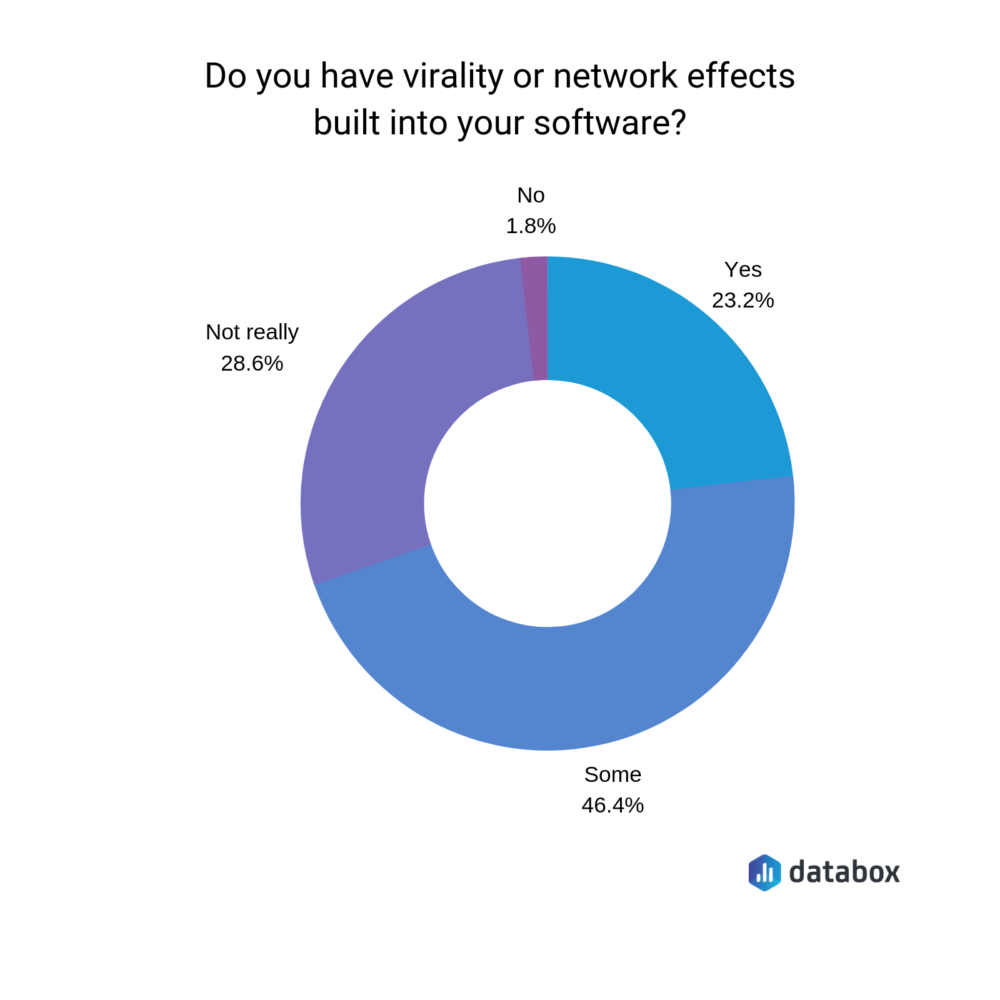
Morandi continues: “Our users can decide to install our website chat widget on their website for free, but that comes with a little Callbell branding when opening the widget (users can decide to pay to remove it, but most of them don’t).”
“This approach helps increase the number of times our brand is seen by people visiting our free users website and boost referral traffic coming from there.”
That leads to a huge spike in brand awareness because Morandi says “we know that our widget is seen on average 50K times over a day by an average of 20K people around the web. Out of those 20K, around 2% click on the widget at least 1 time during a session (that’s where our branding appears so it counts the number of times people are exposed to our brand).”
Baptiste Debever says Feedier offers a free-forever version of their software “because we want to make feedback the norm, and we strongly believe that providing good free software is a great way to get the word out there and drive awareness.”
Plus,FYI‘s Marie Prokopets says they “chose freemium because we knew that with our product being in a new market we had to make sure that people have the lowest friction possible to using it.”
“By having a free forever plan, we’re able to get more people exposed to the experience the product provides, faster.”
Monika Ciemiecka of Appoint.ly also “wanted to offer both free and paid plan because the more people use our app the more people get to know about it.”
According to Ciemiecka, freemium access is the best of both worlds because “the freemium plan is the benefit for users and it increases traffic, and then it’s our turn to constantly increase the conversion from free to paid users.”
When you want to appeal to companies with a small (or lack of) budget
Think about the buyer personas you’ve put together for your target users.
Are they working at small companies? If so, you might benefit from offering a freemium plan.
“Some of our clients are able to get what they need from the free version of the software,” writes Tradogram‘s Kyle Strong. “Sometimes these clients want to scale their usage of the software after reaching a certain level of success in their business – that’s when the premium plan makes sense.”
“In many cases, new customers upgrade to premium straight away to bypass the restrictions of the free account. Because the price point is affordable, the payment is an inconsequential obstacle to reaching a fully functional tool that meets their needs fully.”
Strong continues: “The model works in our niche because individuals from companies of all sizes are looking for a software tool that offers what we provide. This means that both well established businesses with budgets, as well as individuals who are operating on their own budgets are looking for ways to enhance their productivity within their space.”
The majority of businesses we surveyed said their main user is a practitioner:
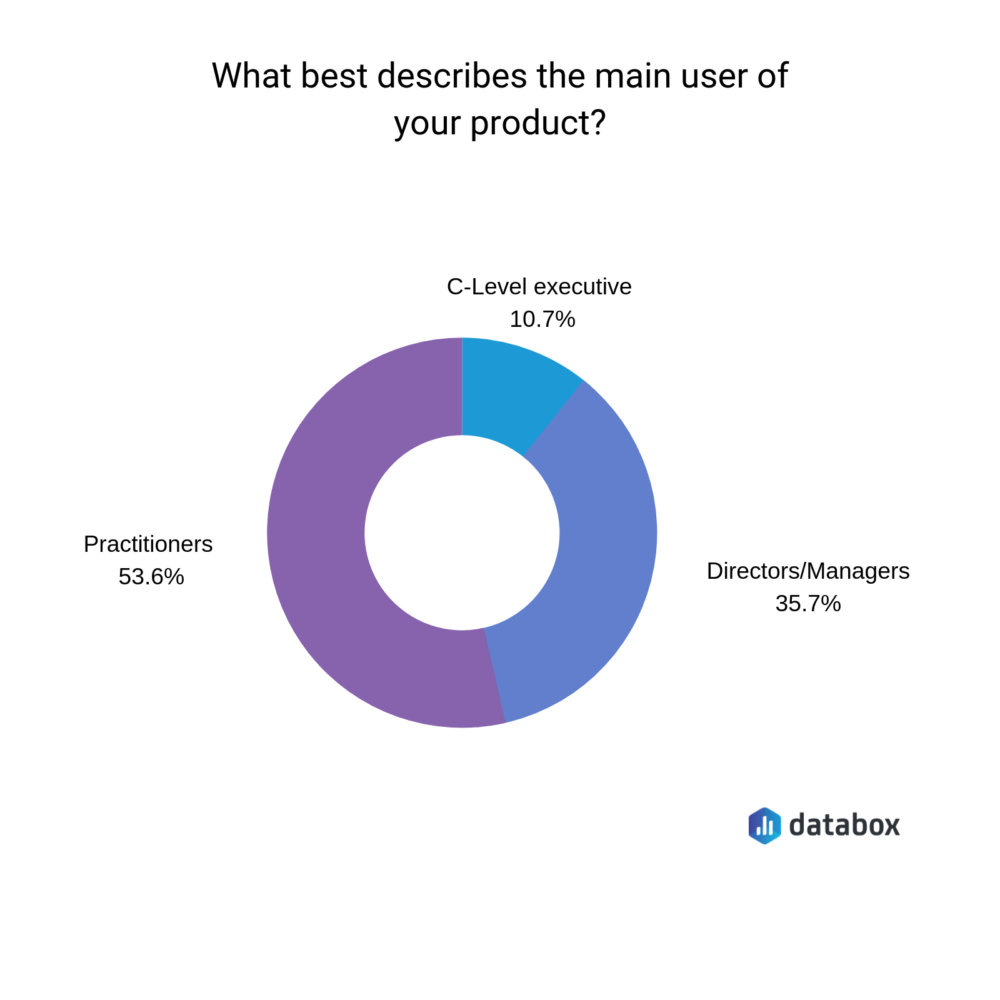
But Strong, who’s business target a range of users, says: “In the cases where a full budget is available, our software is affordable enough to make a quick buy-in decision. For individuals who are just starting out with a digital transformation of their workflow processes, a free account allows them to establish a personal workflow first, before scaling their usage with premium.”
That’s why Strong thinks “having the flexibility to cater to both midsize organizations, as well as entrepreneurs and small businesses that are looking for a small or personal-level solution means that our marketing efforts resonate with a more diverse user base than if we were to target the midsize businesses alone.”
When your sales team spends lots of time giving product demos
Research has found that prospects are already 57% of the way through the purchase process before speaking to a rep.
You could speed that up–and cut the time your sales team spend giving demos–by offering a freemium product.
VYPER‘s Jack Paxton notes that the freemium model “gives people the chance to see if the product is a good fit for their brand,” which also “decreases risk as we do not ask for payment or credit card on sign up.”
“We allow people to see 100% of the product so they know exactly what they can expect when they start paying. We want to show value (features and benefits) before we ask for a credit card.”
“We also chose to do it this way so we did not have to charge a high price to have sales reps to individually give product demos. Product demos are also always rigged to look perfect, someone who uses the tool all day every day makes it look easy.”
“We want the user to experience how easy it is to use by themselves so they don’t purchase our tool then have no idea how to use it,” Paxton writes.
Aslam Abbas also adds that offering Collect.chat‘s “software for free reduces the friction in user onboarding.”
“The power of our product (chatbot building platform) is felt the moment they log in and create their first chatbot in minutes. That is the “Aha” moment for our users. Once they realize how easy it to build the bot, then they think about other factors, like how is the billing structured,” Abbas explains.
Not a Pipedrive user? We have similar dashboards for HubSpot, Salesforce and Intrix.
When your customers don’t see value within a specific timeframe
Did you know that smaller B2B sales cycles fall around 3 months? If that wasn’t shocking enough, consider this: It takes between 6 and 9 months, on average, to close a substantial B2B sale.
“Our product offers a new way of hiring, and we want users to have an opportunity to see experience it without having to go through procurement or make too many decisions. So instead of only offering an opportunity for a demo (which we also do), we let prospective customers explore the product on their own terms,” explains Omer Molad of Vervoe.
“A free trial with a time limit isn’t a great fit because companies aren’t always hiring regularly, so to limit them to 7 or 14 days doesn’t really work.”
A freemium model eliminates the trouble of finding a suitable trial period.
John Pooley of Milanote explains: “It’s important for prospects to spend enough time in the product to see the value. And because people use it differently, a suitable trial period could vary from days to months.”
Olga Mykhoparkina also chose the freemium model for the same reason. Their tool, “Chanty, is a team chat that doesn’t deliver instant value (like marketing products. Think ‘Ahrefs’ for instance). It delivers value over time.”
“If we chose free trial, people would not convert into premium that well. […] The value people get comes after turning their team space into a hub where all their communication and collaboration takes place.”
Mykhoparkina adds that this process “takes time – you have to onboard all the team members, set up channels, connect all the apps you need and, most importantly, generate enough messages in the chat so that every time you need to find ‘that’ message, link or file you’ve shared one day, you search it in Chanty, not somewhere else.”
“For every company this time varies, so it’s impossible to put it in a day limit that free trial requires. This is why we’ve chosen freemium.”
The majority of companies we surveyed said their product was easier to set up in comparison to their competitors:
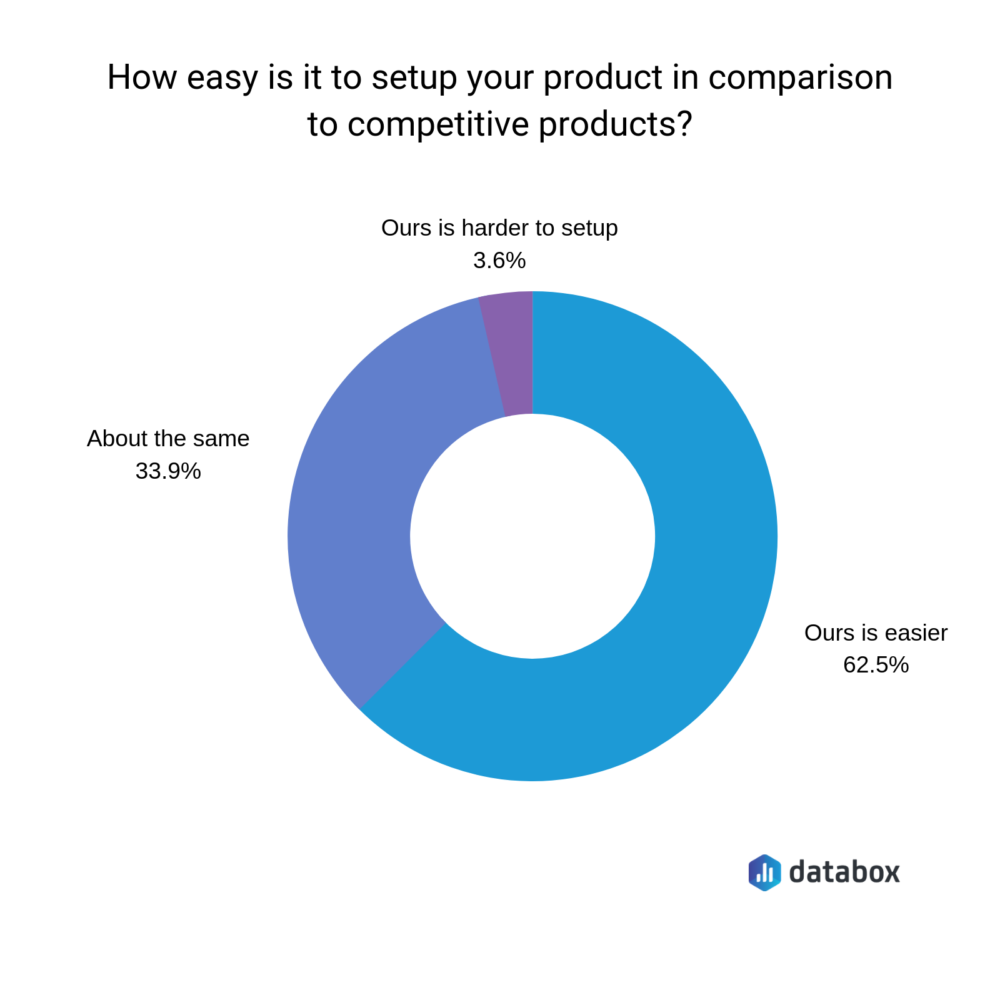
But if Filip Podstavec says that Marketing Miner “has a long-term learning curve so we need to provide to our users enough time to learn with our tool”–hence why they offer a freemium version of their software.
Mark Walker adds to that: “My primary SaaS product (Transporters.io) is freemium, primarily because our service becomes the heart of the business so is a major commitment to make the switch for existing businesses.”
“We have a long slow process for many users to get started and fully adopt our software. Many take months or even years to get set up and started, or start off only using part of the product and upgrade later.”
When your Net Promoter Score needs to increase
Fabricio Pamplona says Mind the Graph “have a free version with restricted features, and a full model under subscription.”
“Our model works like this: we acquired visitors through blog content and Facebook Ads, and around 35% actually register for the free product. A little more remain receiving content and updates as nutrition leads.”
Pamplona notes that “these guys tend to like the product (NPS 70), and around 3% convert into subscribers.”
Research by ProfitWell supports this. The average NPS score is greater for companies with freemium products:
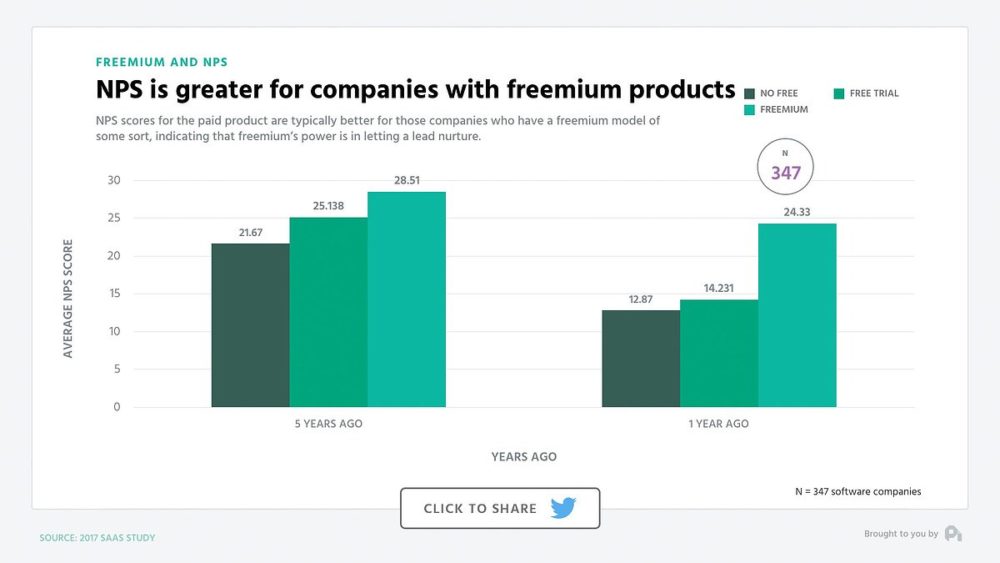
Pamplona continues: “The subscribers receive a full version of the platform and an on-demand illustration service is included. The turnaround is small, our churn rate is around 2-3% and the LTV/CAC is 6:1, which is considered healthy.”
“We tried the trial model and it’s less attractive, because less people get to know the platform. We didn’t want to create something that nobody uses.”
Pamplona adds “the free version generates a buzz and more traffic. Freemium is the best option, and now we are evolving into B2B approaches with customized versions of product.”
PRO TIP: How to Track the Right Metrics for Your SaaS Company
It’s not easy to know which KPIs to track for sales, marketing, and customer success in a SaaS company. There are many possibilities, and so much to do! Why not start with the basic metrics that determine the health of your company?
- Sales (Gross) Volume: How much revenue did your sales team bring in this month, this quarter, or this year?
- MRR Growth: How fast are you growing revenues from recurring subscriptions?
- Customers: How many customers do you have right now?
- Customer Churn Rate: What’s your customer churn rate, and how much revenue have you lost to churn?
If you want to track these in Stripe, you can do it easily by building a plug-and-play dashboard that takes your Stripe customer data and automatically visualizes the right metrics to allow you to monitor your SaaS revenue performance at a glance.
You can easily set it up in just a few clicks – no coding required.
To set up this Stripe dashboard, follow these 3 simple steps:
Step 1: Get the template
Step 2: Connect your Stripe account with Databox.
Step 3: Watch your dashboard populate in seconds.
When does a free trial model work?
Almost 35% of the pros we polled said their company offered a free trial–access to their product for a limited period.
Whether it’s a time-limited access or credit-based system, our experts think you should offer a free trial when:
When you want to attract a small number of high-quality customers in a large market
“A free trial is best for tools that are relevant for a smaller set of people in a niche market that have some setup required,” says Ananta Adithya of Outgrow.
“During the Outgrow free trial, we work closely with companies to ensure that they are successfully able to test out the different features that are available in Outgrow, and are also able to embed the content pieces on their website to see how well their outreach strategy is working.”
Adithya continues: “We stay in touch with each user to guide them throughout the process. We also offer engaged users a call and provide them with personalized interactive content ideas for their business.”
The majority of businesses we surveyed said the market they’re working in is either “big” or “huge”:

AmazeOwl‘s pricing model has been through some changes because of their market size, as Oleg Zaideiner explains: “We started with free forever, then added paid tiers, then moved to free-trial and onboarding emails, messages.”
While Zaidiner notes that a freemium model is “amazing tool to bring a lot of traffic with almost 0 marketing spend, […] the quality of traffic is not good enough and business-wise it was the wrong decision.”
That’s why Zaidiner thinks “free model works in huge markets, but in our case, the market is limited by 200-300k users and it’s a bad business model.”
It’s also smart to consider the maturity of your market, too. If you’re one of the 37% of software experts working within a market that is either “not mature” or “non-existant,” your free trial can showcase the features (that customers might not be used to) you’re offering.
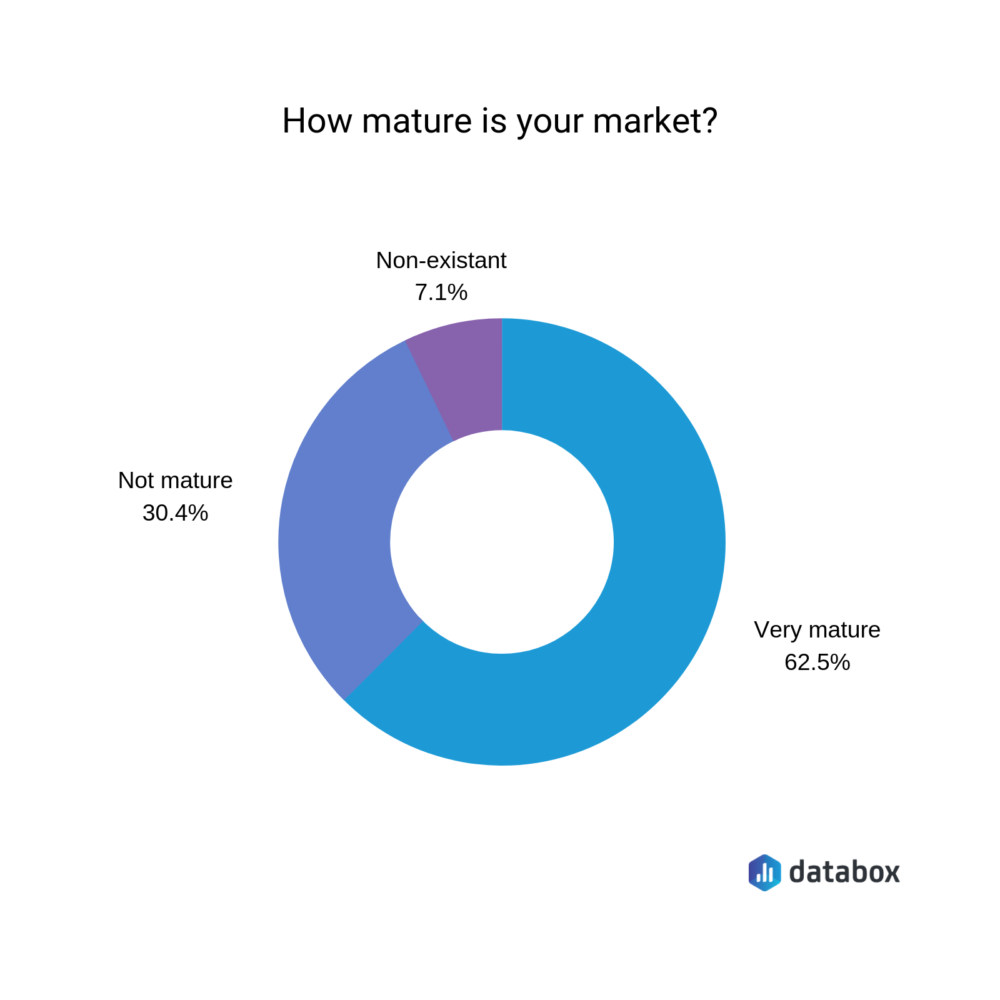
“We tested both (free versus free trial) and we found out that a free trial attracts more professional businesses than a free product,” writes Niklas Dorn of Filestage.
“Typically users start a trial via our website. They can test our product with no strings attached. At the same time, we invite them for a free demo and personal consultation with one of our workflow experts. […] This works fine because we have fewer trial users (than before), but more serious once than before when we worked with a free model.”
“We learned that when users had a personal conversation / demo with us they are a lot happier, have fewer support requests and are a lot more productive. Overall it seems like they get more value from the software once we set up the workflow together with them.”
“Having this personal relationship wouldn’t work with a completely free product,” Dorn says.
LiveAgent offers a free trial of their paid software–something David Cacik says is a result of limiting “some of the functionality of the product to avoid fraud and spam-sending.”
When users need reassurance pre-purchase
Ever heard the phrase “You don’t know what you’re missing”?
The same concept could be applied to the free trial model. If customers don’t know the features they’re missing out on, they might struggle to hit “purchase”.
…But if they’ve already had hands-on experience in the form of a time-sensitive trial, they know what they’re missing–and can sign up to the paid plans if they can’t live without it.
Kontentino‘s Bohumil Pokstefl say they offer a free trial of their paid software because of this: “Firstly, leads need to discover the value of the product and have hands-on the product. Afterward, they are able to pay.”
“Usually, our customers plan social media content for one month in advance. That is why we have 30 days of a free trial, to actually see some results.”
Livestorm‘s webinar and video conferencing software is event-based, which is why Thibaut Davoult says they have a free trial on offer: “Trying out the platform before an actual event and making sure everything will go as smoothly as possible is extremely important for all our customers.”
“That’s why we have a free trial that is only limited in a number of participants and webinar duration, that means free users can host test webinars in exactly the same setting as they would on a real live session. This helps reassure them and reduces the pressure and guessing-game before their first actual event.”
In fact, the free trial is so successful for Livestorm that Davoult says: “Our conversion rate from free trial to paid customers is 10%. Having a sales rep address high-quality free trials helped improve the Account Lifetime Value by ~30% in the period of one quarter.”
Katia Myroniuk offers a free trial of Audext‘s audio transcription services because “when the prospect wants to satisfy his specific need to convert existing audio to text in a timely manner, he is likely to [compare] a couple of services, rather than just paying for the service right away.”
“That is why we offer 30 minutes for free and allow him to check the quality of our transcription, and then when he is satisfied, he can buy more minutes or subscribe for the renewal of hours according to his needs,” Mryoniuk explains.
Mryoniuk thinks the free trial is beneficial because “since [the] user can see the quality of the product right away without paying upfront, he can identify if the price is reasonable, and likely to become a returning customer.”
Plus, Mryoniuk adds that: “Right now the bounce rate on the site is around 40% and an average time spent on the website is 6 minutes, which shows that we tackle the search intent, and the solution is popular. The hardest thing is, of course, is to get a user to activate from the free model and become a paying customer.”
“That is why while using this model we constantly update our internal list of disposable emails to restrict the access to the service who simply do not want to pay,” Mryoniuk explains.
When your users are easily distracted or overwhelmed
The average human being an attention span of 8 seconds. We have a habit of multi-tasking–which is probably why you’re reading this blog post with a handful of other tabs open in your browser.
Cloudways offer a free trial of their paid software to combat this.
Muhammad Rehan explains: “The users can pick a provider and try out our services for free in a three-day trial. Once they are satisfied that Cloudways is a great fit for their business model, they can upgrade the account to avail the full range of the platform features.”
According to Rehan, this free trial “allows the users to try out the essential platform features without being distracted with “bells-and-whistles”. During the trial, the users have unrestricted access to the core platform features that they would normally use during their association with Cloudways.”
When you want to give short-term value for long-term potential
It’s not uncommon for SaaS products to provide value to their users over a long period of time.
J.D. Crabtree is in favor of free trials because “one of [Yaguara‘s] biggest selling points is for a trialing customer to immediately integrate their data sources and start working with their real-time data. It would be difficult to understand the platform’s power without an integrated source.”
Plus, Crabtree adds that “we need all this short-term value to bulk up the long-term potential of the platform. We are a goal-setting platform that often needs time (30+ days) to see the full circle value, so we try to show a ton of value and encourage a lot of upfront usage in the 14 day time period to show a glance at what this would look like in the future.”
“Due to our higher price point and request for all plans to have multiple users, we often get reasonably qualified trialing customers.”
Crabtree shares this usually results in a 20% conversion rate and lists a model of what this looks like for their product:
- “10 qualified sign-ups
- 2-5 engaged sales efforts
- 1-2 extended trials
- 2-3 new conversions”
When your product has expensive running costs
“RetargetKit is a self-funded project,” says Iftekher Islam Sunny. “My product holds an amount of server cost. The server cost increases as the number of user increases. So, If I provide freemium, It would turn out very difficult for me to bear the cost of the server.”
Awario offer free trials for the same reason. Masha Maksimava says: “Our tool is pretty expensive to maintain for us in terms of hardware, even in the trial period.”
“Awario is, in fact, a search engine, and there are a lot of heavy machine learning algorithms involved. Being a bootstrapped startup, we couldn’t offer a fully functional free-forever version of our product – that just wouldn’t make financial sense for us,” Maksimava says.
Remember: You don’t want your free trial to sacrifice profits. Your running costs need to be taken into consideration, along with the cost of your product in comparison to your competitors.
Should a free trial require a credit card?
Free trial means free trial. Your customers don’t need to pay to gain access–but there’s a gray line when it comes to renewing once their trial ends.
Think about whether you’re automatically subscribing your customers to a paid plan once their trial ends unless they cancel their account before that time comes.
Huge SaaS brands like Moz and ConvertKit ask for credit card information to gain access to a free trial–as does Vaetas, LLC, who’s product offers a “free 15-day trial that requires a credit card to register” according to V. Michael Santoro.
“Our conversions went up when we required a credit card. It seems that this initial risk-free commitment encouraged them to actually use our software. We also receive high marks for our support during the trial and it continues after they become a paid user.”
Santoro’s team asked for credit card details because “we’re not looking to generate thousands of users with a “free” mentality, but rather attract a smaller group that is willing to pay for value after they had unlimited access to our product for the 15 days.”
In fact, Santoro says the free trial with credit card details results in a 80% conversion rate after the trial ends.
…But what if you’re selling a high ticket item, and don’t want to process refunds to customers who weren’t aware of the automatic renewal?
Dennis van der Heijden says Convert.com “don’t offer trial+credit card forced since we do want different people of the company to be able to discover it. [The] minimum price is $599, so not something that you’d want as an accidental charge.”
When can freemium and free trial work together?
There’s no doubting that freemium and free trials are both superb models that work individually.
But some of our experts think you can offer both–including Kate Bojkov of EmbedSocial, who thinks “it is very easy to get traction or potential users from a free version of a version that actually does something [because] once people love the product they start talking about it, sharing or in our case they embed it on their product.”
However, a free trial “helps bring more users who are possibly willing to use more features, such as advanced customizations and be happy to pay for non-branded version.”
These experts also support the case for both a free trial and freemium model if:
When you need to gain lots of market share
The majority of SaaS companies offer one or the other. That means using both payment models could give you a competitive advantage.
Aleksandar Olic explains the story behind Clockify‘s decision to use a combination of freemium and free trial: “We initially developed the time tracking app for our own needs and decided to offer it for free to other big teams like ours. Once we noticed there was a huge interest, we decided to invest more in development.”
“We’ve developed additional nice-to-have features and introduced paid monthly plans so we can cover further development, support, and infrastructure costs.”
“There are a huge number of time trackers on the market. The problem is, they are either too expensive (most charge around $10/user) or their free plan limits you to just 1 user,” Olic explains.
“We, on the other hand, offer an unlimited number of users, more features in the free version than others offer in their premium packages, and very affordable packages (for example, others charge $200/month for 10 person team while we charge a flat fee of $10 for the comparable plan).”
The cost of a product in comparison to competitors is a great way to analyze which model you should be using–especially when almost 65% of our experts’ products are cheaper than their competitors:
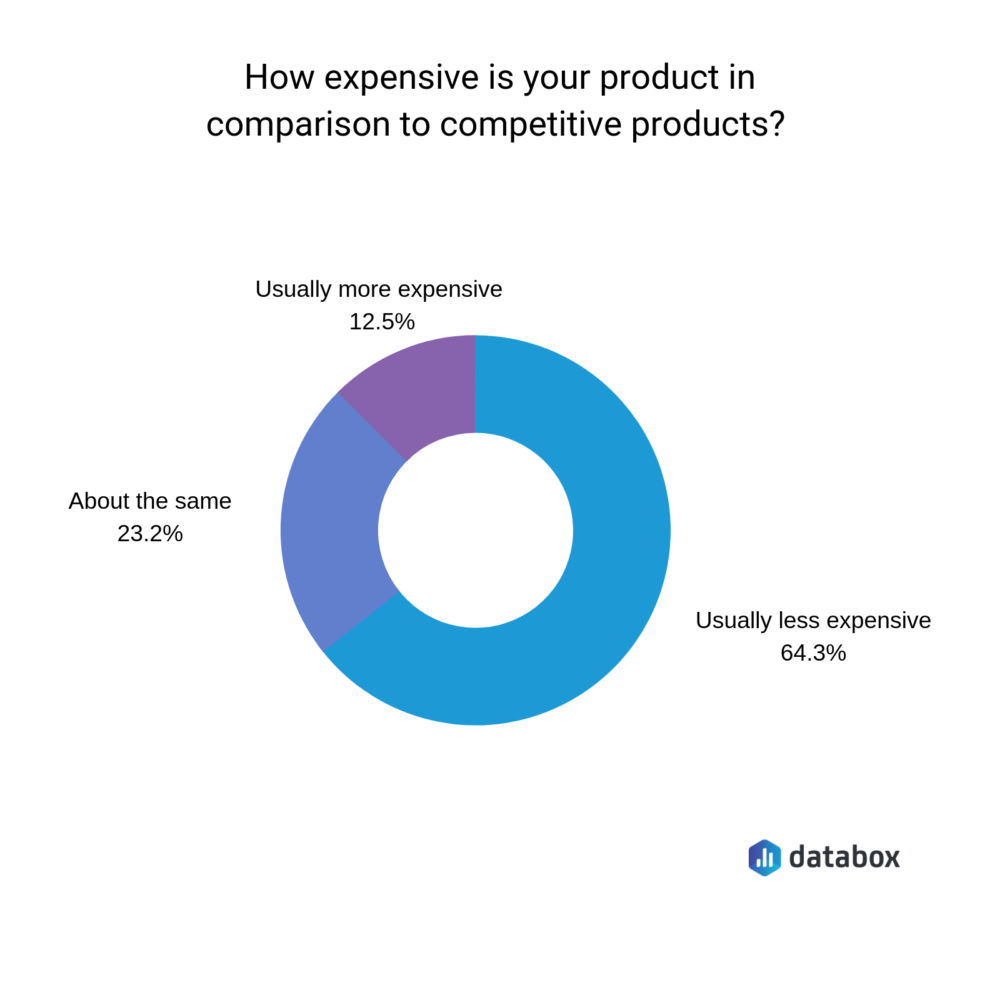
Olic explains that as a result of their freemium and free trial combination, “we have around 50,000 new signups each month (all organic and word of mouth) because we’re providing a better product for fraction of the cost. It’s that simple.”
According to Artur Arseniev, Grapedrop chose the freemium model “mostly to be more competitive in the market. Free-forever versions are also a really good boost from the marketing point of view.”
But Arseniev notes that “the market is really competitive, there are huge teams which deliver great products and it’s really hard to be seen in such environment.”
“So, what we can do to be noticed is to give away as many free features as we can (obviously features that don’t waste too much of our resources) this obviously will decrease significantly the conversion rate (probably also the paid users will switch to the free one),” Arseniev explains.
HelpCrunch also started “with a free trial model from the very beginning (2016), but as more competitors in our live chat software industry started to offer freemium plans, we decided to give it a try as well (in Oct ’19) in hope to acquire tons of new users,” as Daniil Kopilevych writes.
“So as of today, we have both free account signup (as the main CTA on our website), as well as free trials of paid plans (visible on our Pricing page only).”
The result of this change? “We obviously did increase signup conversions; the conversion to paid dropped (which we, again, expected: the current FreetoPaid conversion is around 8%; the old TrialtoPaid conversion was around 15%).”
“However the main expectation was to dramatically increase the number of registrations thanks to marketing the free plan through different acquisition channels and website conversions, and this, in turn, would lead to even more viral marketing,” Kopilevych continues.
“Thus, we decided to get our main free trial flow back in June ’19 and erase 95% of all the mentions of our Freemium plan on our website and external resources.”
Summarizing, Kopilevych says: “I wouldn’t say that free users require more support/sales attention that trial users. However, it’s naturally easier for sales and marketing teams to convert free trial users to paid users thanks to the 14-day access limitation.”
When you have different customers that need different features
Not all of your customers need full access to your product.
In fact, according to Victor Antiu, some of Sleek Bill‘s users “only need the basic invoicing and that is expected to be free. But top users expect more complicated features and they need to see how they work and that we have them.”
For that reason, Antiu’s team “offer everyone a full free trial so everyone can see the full package and also feel the difference when losing them in free.”
Antiu notes that the combination “gives us about 2x better conversion than Freemium and about 5x better than Premium only. The sales effort is also much easier since the client can actually test all the features and does not need a full demo from our team.”
When shouldn’t I offer free trials or freemium access?
Don’t feel comfortable with offering anything for free? Don’t panic.
While offering free access (whether in the form of freemium access or a free trial) can be beneficial, it’s sometimes wiser to ditch them if:
When you’re hiring talent on a service basis
It’s tough to offer free access (be that through a trial or a freemium version) if you have bills to pay–specifically invoices for the specialist subcontractors you’re hiring.
“Since we are providing content creation for different businesses, we have hundreds of freelance writers working with us who need to get paid for their work,” says ContentFly‘s Annika Helendi.
“We wanted to offer the cheapest possible price for quality content and that means we don’t have much room in the pricing for doing discounts or for offering any of our services for free. We do give full refunds if customers are not happy with the content they receive but this rarely ever happens.”
Helendi notes that their “service costs a flat $250 per month that we charge upfront when customers sign up. This seems like an aggressive move for most SaaS founders but in our case, it has proved to be successful. This motivates the clients to put their first content orders in as soon as possible so they wouldn’t lose the money they just paid us.”
When the results you’ll promise clients aren’t instant
Accelity doesn’t offer any free access because “it takes a few months of consistency for measurable results to start showing up” from their services.
Cass Polzin explains: “We used to offer a free trial period, but it was discouraging for customers because we wouldn’t be able to do the same as we would for a paid campaign AND the results wouldn’t look great since it was the first time they were doing anything.”
“We’ve had far higher success closing and retaining using this model over offering a free trial,” Polzin writes.
Final thoughts
Have you decided which model works best for your business? Before rushing to offer a free trial or freemium product, weigh up the pros and cons for the model you’ve selected.
Sure, both have the ability to generate paying customers–but you don’t want to sacrifice your profit margins to get them.
















